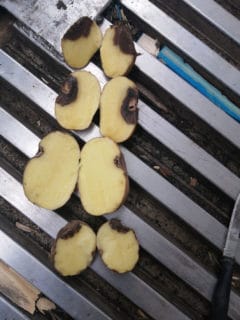Fusarium is the most common fungus responsible for seed-piece decay and dry rot. Although Fusarium is found in most soils, infected seed tubers are the most important sources of inoculum. Planting infected seed results in poor stands and serious economic losses. Soft rot bacteria often invade tubers with dry rot, which causes the seed to rot very quickly.
Identification
- External lesions are sunken and shriveled with concentric wrinkles. Cracks often form in the infected areas.
- Rotting tissue is non-smelly, dark, dry and crumbly. The color can vary from brown to grey to black.
- The cavities that form in rotting tissue are lined with yellow, pink, white or blue mold.
Potato seed infected by Fusarium dry rot. The black colour of the flesh indicates that Fusarium is in the initial “wet phase” before it dries up. PHOTO: EUGENIA BANKS
Disease Cycle
Fusarium cannot penetrate tubers through intact skin. Tubers are infected through wounds or bruises that result from rough handling during harvest, transit or storage. If potatoes are infected at harvest, symptoms are noticeable in storage about a month later.
Fusarium Management at Planting
The management of Fusarium seed piece decay and dry rot requires an integrated approach that includes both cultural and chemical practices:
- Plant certified free of Fusarium.
- Use a registered, effective seed treatment on the seed pieces.
- Inspect seed carefully upon receipt. Grade out suspicious tubers and cut the tubers to check the symptoms. Suspicious tubers may be infected with late blight, not Fusarium.
- Warm seed tubers to 10 C before cutting to minimize injury and promote rapid growth. Cold tubers are very prone to shatter bruising.
- Make sure the cutter knives are sharp and make a smooth cut. Smooth cuts heal quickly. Disinfect seed cutting and handling equipment often. Clean up well between seed lots.
- Do not pre-cut seed if you suspect some Fusarium infection.
- Plant seed in warm soil and cover the seed pieces with as little soil as is practical. Coarse-textured soils warm up faster and are better drained than fine-textured soils. This allows the seed pieces to suberize quickly and helps the plants to become established. Wound healing occurs most rapidly when both, the seed pieces and the soil are close to 15 C.
- Minimize mechanical injury and bruising at planting. Protect the seed from wind and sunlight when planting because dehydration greatly weakens seed.
- Start scouting at crop emergence. Check the seed wherever there is poor emergence. If the stand is good, there should not be major crop losses due to Fusarium dry rot during the season.
Since healthy skin acts as a barrier, anything you can do to prevent cuts, wounds or bruises will go a long way to protecting tubers against Fusarium dry rot.












